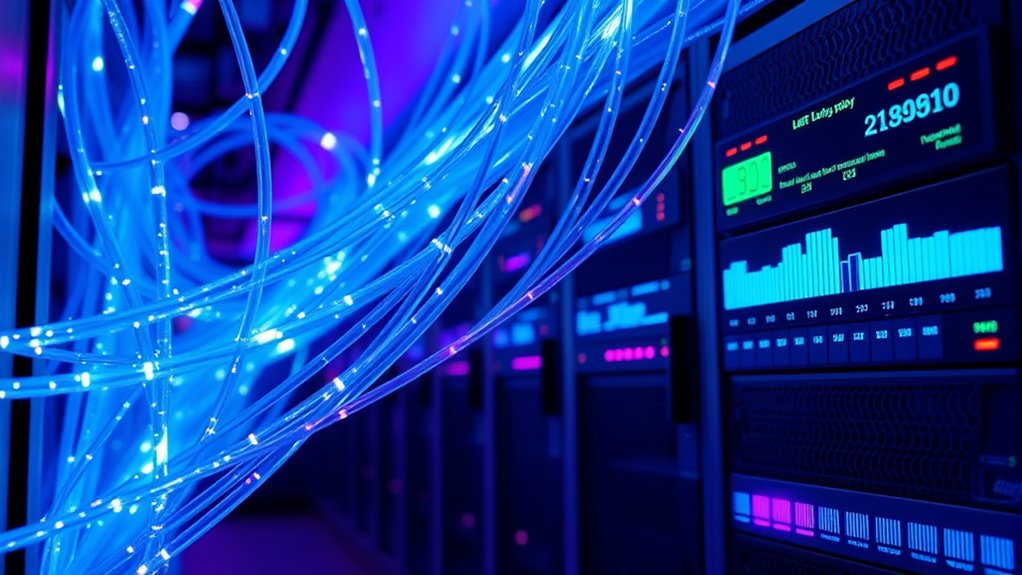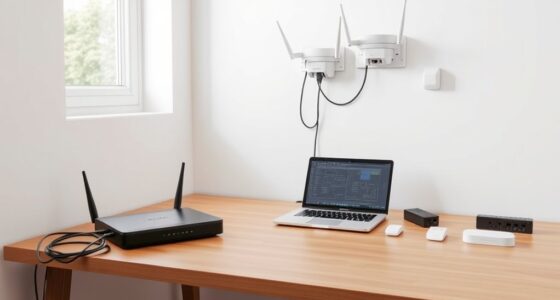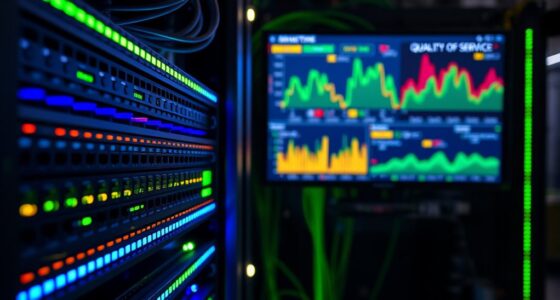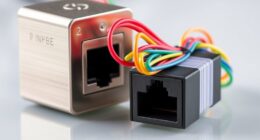It’s no coincidence that many network issues like latency, jitter, and packet loss often occur together, disrupting your online experience. When these problems happen, they usually point to underlying causes such as congestion or hardware failure. Understanding what triggers these issues is essential if you want to find effective solutions. Exploring the root causes and how to address them can help you stabilize your network and improve performance—if you’re willing to look closer.
Key Takeaways
- Network congestion from excessive traffic overloads bandwidth, increasing latency, jitter, and packet loss.
- Faulty or outdated hardware, such as routers and cables, can cause processing delays and physical packet drops.
- Insufficient bandwidth during peak times leads to queue delays and inconsistent data flow, raising jitter and latency.
- Implementing QoS prioritizes critical traffic, reducing latency and packet loss for essential applications.
- Regular hardware maintenance, updates, and diagnostics help prevent issues causing latency, jitter, and packet loss.

Understanding latency, jitter, and packet loss is vital for maintaining quality in network communications. These issues can seriously degrade your experience, causing lag, choppy audio, or frozen video. To effectively troubleshoot and improve network performance, you need to recognize the common causes behind these problems. Two primary culprits are network congestion and hardware issues. When the network becomes overwhelmed with traffic, it leads to congestion, which increases latency and packet loss. During peak usage times, routers and switches struggle to handle the volume, causing delays in data transmission. In such situations, packets sit in queues longer than they should, and some may get dropped altogether, resulting in packet loss. Hardware issues can also play a significant role. Faulty or outdated equipment, such as routers, switches, or network cables, can introduce delays or drop packets. For example, a failing router might process data more slowly or misroute packets, leading to increased jitter and inconsistent latency. Similarly, damaged cables can cause intermittent connectivity problems, resulting in packet loss and jitter that disrupt real-time applications like VoIP or gaming. Regular maintenance and proper configuration are crucial for minimizing these issues, as well as choosing equipment with high performance specifications. Addressing network congestion involves managing traffic more effectively. You can do this by implementing Quality of Service (QoS) rules that prioritize critical data like voice or video streams over less important traffic. Upgrading your internet plan to accommodate higher bandwidth demands can also reduce congestion. Additionally, scheduling large data transfers during off-peak hours minimizes their impact on overall network performance. When it comes to hardware issues, regular maintenance and timely upgrades are essential. Replacing outdated or faulty devices helps guarantee smooth data flow. Checking and replacing damaged cables prevents physical disruptions that cause packet loss. Firmware updates for your networking equipment can fix bugs that may cause delays or packet drops. If you notice persistent problems, testing your network with diagnostic tools can help identify hardware failures or configuration errors. Ensuring your equipment is properly configured and running the latest firmware reduces the risk of hardware-related latency, jitter, and packet loss. Moreover, understanding network parameters like latency, jitter, and packet loss can guide you in optimizing your setup effectively.
Frequently Asked Questions
How Do Network Devices Prioritize Traffic to Reduce Latency?
You can reduce latency by configuring network devices to prioritize traffic through Quality of Service (QoS). QoS allows you to assign different levels of importance to various data types. Traffic shaping manages bandwidth and guarantees critical applications get priority. By setting QoS policies, your devices recognize time-sensitive traffic, such as video calls or gaming data, and handle it first, resulting in smoother, more responsive experiences.
Can Upgrading Hardware Eliminate Jitter Entirely?
Think of your network as a busy highway; upgrading hardware is like widening lanes, but it can’t eliminate all traffic jams caused by hardware limitations or bandwidth constraints. While better equipment can reduce jitter considerably, it can’t entirely remove it if underlying limitations persist. So, although hardware upgrades improve performance, some jitter may still remain, especially during peak usage, because physical constraints and network demands continue to challenge perfect flow.
What Are the Effects of Packet Loss on Voip Quality?
Packet loss seriously impacts your VoIP quality by causing missing audio segments, making conversations choppy or unintelligible. When packets are lost, error correction and packet retransmission mechanisms try to recover the data, but delays can still occur, disrupting the flow. This results in reduced clarity and increased frustration during calls. To improve quality, make certain your network supports reliable packet delivery, minimizing loss and maintaining smooth, clear communication.
How Does Congestion Impact Jitter in Real-Time Applications?
Oh, the irony isn’t lost on you—network congestion actually makes jitter worse, even if you try to buffer it out. When your network gets crowded, jitter buffers struggle to keep up, causing those annoying audio glitches in your real-time apps. Congestion overwhelms the buffers, leading to uneven packet arrival times. So, instead of smoothing things out, congestion makes jitter worse, sabotaging your seamless communication efforts.
Are There Specific Protocols to Minimize Latency in Gaming?
To minimize latency in gaming, you should use QoS configurations to prioritize gaming traffic over other network data. Additionally, game server optimization helps reduce delays by ensuring servers are close to your location and efficiently managed. These strategies work together to improve your gaming experience, providing smoother gameplay with less lag. Regularly updating your network hardware and choosing wired connections can also further reduce latency and enhance your overall gaming performance.
Conclusion
Think of your network like a busy highway. When traffic flows smoothly, deliveries arrive on time; but when congestion or accidents occur, delays and dropped packages happen. By implementing QoS, upgrading equipment, and managing traffic, you keep your data moving efficiently—like clearing the road for a smooth ride. Just as a well-maintained highway prevents pileups, these solutions help you avoid latency, jitter, and packet loss, ensuring your real-time applications run seamlessly.








